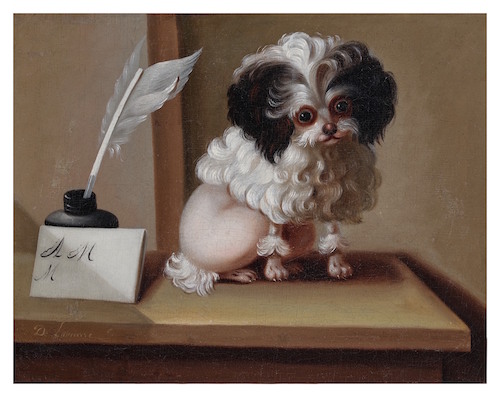The Back Room
The Back Room: Working for the Weekend
This week: London Gallery Weekend, Mike Bloomberg's philanthropic flex, a doggone surprise in the Old Master market, and much more.

This week: London Gallery Weekend, Mike Bloomberg's philanthropic flex, a doggone surprise in the Old Master market, and much more.

Artnet News

Every Friday, Artnet News Pro members get exclusive access to the Back Room, our lively recap funneling only the week’s must-know intel into a nimble read you’ll actually enjoy.
This week in the Back Room: lasting impressions from London Gallery Weekend, Mike Bloomberg’s philanthropic flex, a doggone surprise in the Old Master market, and more—all in an 7-minute read (2,064 words).
_____________________________

Installation view, Jacqueline Humphries at Modern Art. Photo by Michael Brzezinski.
A few years ago, London Gallery Weekend was created out of a shared acknowledgment that Frieze Week in October was no longer enough to sustain the city’s scene. The stakes have risen even higher since the inaugural edition.
The continuing logistical chaos of Brexit exacerbates the difficulties caused by rising inflation and lofty interest rates. Paris has become a sexier, business-friendlier option in the region. The sheer sprawl of the city means that even the savviest, most committed British patrons must be surgical about their itineraries.
So the irony of London Gallery Weekend is that its challenges typify why the city’s dealers need such an unwieldy event to succeed. But on some level, the sensory overload is the point—especially if you’re hunting for who or what has the momentum to rise above the global din in the months ahead.
With that in mind, the intrepid Naomi Rea went on a cannonball run through the latest edition. She came away convinced that art pros should take heed of three questions that were driving much of the energy at London Gallery Weekend 2023, as well as a handful of artists harnessing that energy uncommonly well…
What Is “Contemporary” Abstraction, Anyway?
Look, it would be wrong to say that figuration is over. But to paraphrase Gary Garrels, the latest ex-museum bigwig to pursue a career reboot in the for-profit sector, the pendulum is most definitely swinging back toward nonfigurative work.
For London Gallery Weekend, Gagosian activated its Davies Street location with “To Bend the Ear of the Outer World,” a Garrels-curated exhibition of 40 living artists trafficking in what we’re now apparently terming “contemporary” abstraction.
Garrels asserts that contemporary abstraction knows no singular school or movement. Instead, it’s an array of individuals charting their own nonrepresentational vision and the courage of their convictions.
Sure, the flag flies over canonical elders such as Frank Bowling, Brice Marden, and Gerhard Richter, as well as middle-aged blue chippers such as Mark Bradford, Cecily Brown, and Julie Mehretu.
It was no surprise that the mix included the unstoppable Jadé Fadojutimi or even Zombie Formalist survivors Tauba Auerbach and Oscar Murillo.
But the most exciting contributions came from an artist who has only attracted major attention very recently: 63-year-old Jacqueline Humphries, whose canvases add digitally native gestures meditations on the history of abstraction (and have been gathering strength ever since their inclusion in Cecelia Alemani’s Venice Biennale).
Humphries wasn’t just a standout in the Gagosian show; her solo outing across both locations of British gallery Modern Art drove home that she is a force to be reckoned with (and competed for) in a new era of interest in the nonfigurative.
How Do We Relate in a Post-Brexit, Post-Covid World?
Even if we set aside the screaming headlines around cancel culture, Naomi writes, the fact is that “many of us have continued to feel the knock-on effects of being physically isolated for several years, and events and openings still don’t totally feel ‘back to normal.’”
So it makes sense that another area to watch in the months ahead is artwork that engages with intimacy and moralism (or anti-moralism).
The gravitational center of this theme last weekend was “Hardcore,” a group show on sexuality and kink at Sadie Coles HQ. Although some of the 18 featured artists “felt tame,” others pushed boundaries in ways that have helped seriously boost their art world presence of late, including…
How Should Art Engage With A.I. and Other Disruptive Tech?
As sick as you may be of hearing about artificial intelligence, get used to it being a part of the art industry. But London Gallery Weekend reinforced that the technology is becoming just as consequential to art-making as to business or the law.
One of the most interesting explorations came from Maisie Cousins, whose thought-provoking, algorithm-enabled work at T.J. Boulting continues the artist’s quest to relive lost childhood memories.
“Nestled among real family photos are 19 glossy prints of A.I.-generated images based on memories of lost home videos of trips to an amusement park with her late grandfather,” Naomi writes. The machine-dreamed images “recall Martin Parr’s saturated images of British seaside life, if they were on acid.”
For a newer-school approach, look to Jake Elwes’s Zizi – Queering the Dataset at Gazelli Art House. Here, the artist short-circuits standardized facial recognition technology by feeding the algorithm thousands of images of drag performers, forcing its binary gender conclusions to cope with the possibility of gender fluidity.
___________________________________________________________
To Naomi, what these standout artists share—the contemporary abstractionists, the sexual and moral provocateurs, the technological experimenters—is that they are all grappling with the “existential nausea” of living in the 2020s: the isolating and scary present, mass uncertainty about the future, and the inadequacy of the systems, forms, languages, rules, and social mores available to address these ruptures.
That might not sound like the domain of market darlings. But it certainly sounds like the domain of biennials—and, more importantly, the tensions that define the everyday experiences of people in high-income countries.
If these issues and artists could lodge in such a keen observer’s mind despite the manic competition of London Gallery Weekend, then it’s reasonable to suppose they could do the same for tastemakers and market-makers despite the manic competition of the global art circuit.
So keep your eyes peeled and your ears open for what kind of presence they have in Basel next week and the next wave of events to come.
_________________________________________________________
The latest Wet Paint delves into the poker tournaments energizing the increasingly buzzy Bowery space Amanita, plus investigates the closure rumors circulating around Tribeca gallery Queer Thoughts.
Here’s what else made a mark around the industry since last Friday morning…
Art Fairs
Auction Houses
Galleries
Institutions
Tech and Legal News
_________________________________________________________
“I can afford it. And they need the money.”
—Michael Bloomberg, on his newly revealed $130 million donation to PAC NYC, the forthcoming performing arts center slated to (finally) be constructed on the World Trade Center site. Bizarrely, Bloomberg’s gift dwarfs the $75 million donation made by Ronald Perelman, for whom the institution is still technically named—and matches the amount Bloomberg has given to the Shed to date. (New York Times)

Jacques Barthélémy Delamarre, Portrait of a small poodle, said to be “Pompon,” a beloved dog of Marie Antoinette. Courtesy of Sotheby’s.
____________________________________________________________
Date: Late 18th / early 19th c.
_____________________________________________________________
Seller: Private collection, Connecticut
_____________________________________________________________
Estimate: $3,000 to $5,000
_____________________________________________________________
Sold For: $279,400
_____________________________________________________________
Sale Date: May 26, 2023
This unassuming portrait of an adorable little canine, possibly one with a royal pedigree, smashed its high $5,000 estimate by more than 50X to sell for $279,400at Sotheby’s Master Paintings Part II auction in New York on May 26.
According to Sotheby’s catalogue, very little is known of Jacques Barthélémy Delamarre, though he was admitted to the Paris Académie Saint Luc in 1777. He seems to have had a particular specialty in capturing the likeness of this dog, known as “Pompon,” supposedly a beloved pet of Marie Antoinette. The artist created several different versions with variations in the dog’s size, grooming and the objects surrounding him.
“Depending on one’s point of view, the painting represents either the epitome or a parody of eighteenth-century French art,” said Old Master expert and dealer Robert Simon, who was following the sale. “Or maybe a bit of both. And it is that over-the-top quality which makes it easy to love.”
There are several versions of the painting, both contemporary and later, and this is one of the finest, if not the finest, according to Simon. The auction room action for this particular painting was also evidence that ‘no reserve’ auctions are more competitive and perhaps more fun. “I watched this live as it played out slowly like an interminable tennis match,” Simon said. “Clearly two deep-pocketed people loved the little guy!”
—Eileen Kinsella